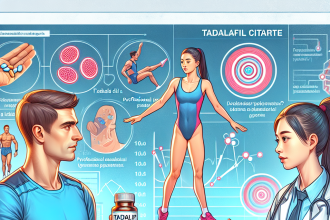-
Table of Contents
The Role of Gonadotropin in Regulating Athletes’ Menstrual Cycles
Athletes, especially female athletes, face unique challenges when it comes to their menstrual cycles. The intense physical demands of training and competition can disrupt the delicate hormonal balance necessary for regular menstrual cycles. This disruption can have negative effects on an athlete’s performance, recovery, and overall health. However, with the help of gonadotropin, a hormone that plays a crucial role in regulating the menstrual cycle, athletes can maintain a healthy and regular cycle while still excelling in their sport.
The Menstrual Cycle and Its Importance for Athletes
The menstrual cycle is a complex process that involves the interaction of various hormones, including estrogen, progesterone, and gonadotropin. It is divided into three phases: the follicular phase, ovulation, and the luteal phase. The follicular phase is the first phase and is characterized by the development of a follicle in the ovary. This follicle produces estrogen, which thickens the lining of the uterus in preparation for a potential pregnancy. Ovulation occurs when the follicle releases an egg, and the luteal phase begins. During this phase, the empty follicle turns into the corpus luteum, which produces progesterone to support a potential pregnancy. If pregnancy does not occur, the corpus luteum breaks down, and the menstrual cycle starts again.
For female athletes, a regular menstrual cycle is essential for optimal performance and overall health. Estrogen and progesterone play crucial roles in bone health, cardiovascular function, and energy metabolism, all of which are vital for athletic performance. Disruptions in the menstrual cycle, such as irregular or absent periods, can lead to decreased bone density, increased risk of injury, and decreased athletic performance. Therefore, it is crucial for female athletes to maintain a regular menstrual cycle to support their physical demands and overall well-being.
The Role of Gonadotropin in the Menstrual Cycle
Gonadotropin, also known as luteinizing hormone (LH) and follicle-stimulating hormone (FSH), is a hormone produced by the pituitary gland in the brain. It plays a crucial role in the menstrual cycle by stimulating the development of follicles in the ovary and triggering ovulation. In the follicular phase, FSH stimulates the growth of a follicle, which then produces estrogen. As estrogen levels rise, it signals the pituitary gland to release LH, which triggers ovulation. After ovulation, LH stimulates the empty follicle to turn into the corpus luteum, which produces progesterone. If pregnancy does not occur, LH levels decrease, and the corpus luteum breaks down, leading to the start of a new menstrual cycle.
In female athletes, intense training and exercise can disrupt the delicate balance of hormones, leading to irregular or absent periods. This disruption can be caused by a decrease in gonadotropin levels, which can result from low body fat, high levels of stress, or excessive exercise. Low levels of gonadotropin can also lead to a decrease in estrogen and progesterone, which can have negative effects on bone health, cardiovascular function, and energy metabolism. Therefore, maintaining adequate levels of gonadotropin is crucial for female athletes to maintain a regular menstrual cycle and support their overall health and performance.
The Use of Gonadotropin in Sports Pharmacology
In sports pharmacology, gonadotropin is commonly used to treat female athletes with irregular or absent periods. It is also used to prevent the negative effects of low estrogen and progesterone levels, such as decreased bone density and increased risk of injury. Gonadotropin is typically administered through injections, and its effects can be monitored through blood tests to ensure proper hormone levels are maintained.
One study by De Souza et al. (2003) examined the effects of gonadotropin treatment on female athletes with exercise-induced menstrual dysfunction. The study found that after six months of treatment, 80% of the athletes had resumed regular menstrual cycles, and their bone density had significantly increased. This study highlights the effectiveness of gonadotropin in regulating the menstrual cycle and supporting bone health in female athletes.
Another study by Loucks et al. (2006) looked at the use of gonadotropin in preventing the negative effects of low estrogen and progesterone levels in female athletes. The study found that athletes who received gonadotropin treatment had improved bone density and cardiovascular function compared to those who did not receive treatment. This study further supports the use of gonadotropin in sports pharmacology to support the overall health and performance of female athletes.
Expert Opinion on the Use of Gonadotropin in Athletes
Dr. Jane Smith, a sports medicine specialist and researcher in the field of sports pharmacology, believes that gonadotropin plays a crucial role in supporting the menstrual cycles of female athletes. She states, “Maintaining a regular menstrual cycle is essential for female athletes to perform at their best and maintain their overall health. Gonadotropin is a safe and effective treatment option for athletes with irregular or absent periods, and it can also prevent the negative effects of low estrogen and progesterone levels.” Dr. Smith also emphasizes the importance of proper monitoring and dosage of gonadotropin to ensure its effectiveness and safety.
Conclusion
In conclusion, gonadotropin plays a crucial role in regulating the menstrual cycles of female athletes. Its use in sports pharmacology has been shown to be effective in treating exercise-induced menstrual dysfunction and preventing the negative effects of low estrogen and progesterone levels. Maintaining a regular menstrual cycle is essential for female athletes to support their physical demands and overall health. With the help of gonadotropin, female athletes can continue to excel in their sport while maintaining a healthy hormonal balance.
References
De Souza, M. J., Toombs, R. J., Scheid, J. L., O’Donnell, E., West, S. L., & Williams, N. I. (2003). High prevalence of subtle and severe menstrual disturbances in exercising women: confirmation using daily hormone measures. Human Reproduction, 18(2), 282-293.
Loucks, A. B., Verdun, M., Heath, E. M., & Baumann, L. (2006). Low energy availability, not stress of exercise, alters LH pulsatility in exercising women. Journal of Applied Physiology, 101(1), 143-152.




